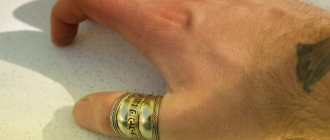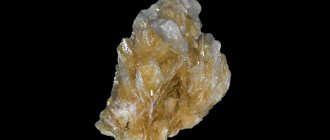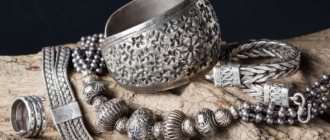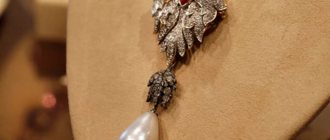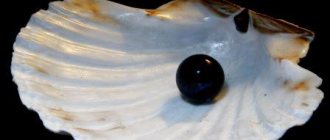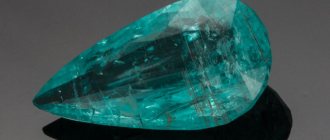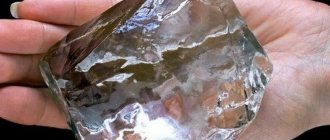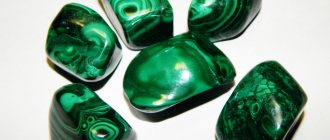Ring
Rings are worn by both women and men. Especially when it comes to engagement rings. They can be made from precious metals (gold, platinum) or silver. There are options that combine elements of different origins.
Wedding rings are the most striking example of this type of jewelry
Signs that you have a ring in front of you:
- The rim of the ring is not too wide and thick.
- The ring is decorated with several small stones or an ornate pattern .
- The rim can be solid or openwork.
- The product is not impressive in size and does not take up half a finger.
Most often, rings are very elegant and light products.
The ring can be decorated with many stones, but this does not make it massive
Ring and signet - what's the difference?
The jewelry is different from each other, although both are considered a variation of the ring. We suggest you understand the difference between silver signets and rings for men:
- In the first case, there is no insert on the surface of the product. It is replaced by a pattern printed on the front of the tire. If earlier this role was played by images of coats of arms, now these can be unusual patterns, symbols of zodiac signs. Men continue to wear items with initials, but no longer use them to authenticate documents.
- A silver signet with a stone is considered a ring, even if the base is encrusted with small crystals. This is due to the fact that historically the first piece of jewelry indicated the status of the owner, and the second - wealth.
- Thanks to their sophisticated design and colored stones, rings are popular among women. A large insert that shines on the finger transforms a simple look into an elegant and luxurious one. A silver signet with a coat of arms or other design is a purely masculine decoration.
- A product with an image on a tavern may have a certain meaning, so it is worn face down. The smooth surface does not cause discomfort in everyday life because it does not cling to clothes. The principle of wearing face down does not apply to products with inserts, because they are easy to damage. A large silver ring with a stone should not be hidden from the eyes of others. This is an element of a stylish image that should be in plain sight.
Rings
These massive products are necessarily decorated with a large convex stone
. It can be both precious and ornamental. It was thanks to certain characteristics of the stones that the properties of amulets and talismans were attributed to such jewelry.
Initially, such jewelry was worn exclusively by men due to its massiveness. Many of them became symbols of power and might. If you pay attention to the numerous portraits of rulers of powers or noble nobles, you will notice how carefully all the rings and rings on their hands are drawn. It was the rings that became symbols of power. They were passed down from generation to generation, from the head of the family to the first heir.
The most famous rings are:
- Ruby ring of Paul II
, which he received after his initiation as a Grand Master. It is currently kept in the Hermitage. - Ring of King John the Landless of England with turquoise
, with which he checked whether food was poisoned. According to legend, this stone changes color in the presence of any poison. - The magical ring of the Prophet Muhammad
was decorated with carnelian. - Each Pope, upon ascending the throne, receives a ring called “ Fisherman
”. A personal ring is made for each new ruler of the Vatican.
There are many legends about rings with hidden places. They contained images of lovers, locks of their hair, as well as powerful poisons. For example, many pieces of jewelry from the Borgia family, known for dealing with their ill-wishers using poisons, contain similar containers. Members of this family not only knew a lot about various poisons, but also independently developed designs for rings with various cunning devices that allowed them to store poison in them.
The most famous of them are the Flame of the Borgia
and
The Lion's Claw
. In the latter, a special needle with poison was installed, which came into action when shaking hands.
History of men's rings
Historically, rings have played a very important role in business, politics, religion and culture. In the good old days, a gentleman used his ring to display his family crest, emblem or monogram to sign legal or important documents, some of which played a prominent role in our history. By dipping the ring into hot wax or soft clay, the ring left a special symbol that was considered at the time something more official than just a painting.
The ring itself had a marking that meant either a specific person, or his belonging to a family and clan, or to a certain circle of people. Most often it was a family coat of arms or emblem, much less often a badge or monogram, somehow connected with the person. The ring was made in a mirror image so that the imprint or seal had the correct shape. Many world leaders wear these signet rings every day, others hide them under seven locks.
Signet rings have been in use as far back as 3500 BC, when Mesopotamians began using them as a method of authentication. Initially, the signet ring, unlike the ring, had a cylindrical shape and was used for making impressions on wet clay. It was used to seal various envelopes, cans and packages, and in essence it was similar to the seal of a legal entity in modern times. Then, in Ancient Egypt, the ring began to be worn by pharaohs, religious leaders and nobles. Often these rings were made of stone or earthenware.
The rings were richly decorated with stones and sacred symbols on the outside to indicate the status of their owner. For example, some men wore a ring on their thumb, others on their index or ring finger. The chosen finger, as well as the style and material of the ring, could say a lot to the owner.
Even in the Old Testament you can find references to the signet ring, in the story of Daniel in the lion's den...
And a stone was brought and laid on the mouth of the ditch; and the king sealed it with his ring, and with the ring of his nobles; (Daniel 6:17)
In the early days of the Minoan civilization, rings were made from soft stone and ivory. In the Middle Minoan era, they were already made from harder stone, and by the end of the Bronze Age, the rings acquired the form in which we know them today. In the Hellenistic period, in addition to being used for certain purposes, they were also considered to have artistic value. King Mithridates VI of Pontus was a passionate collector of rings.
In medieval times, almost every person of noble blood not only wore a ring, but also actively used it to leave a signature or seal on important documents. In the fourteenth century, King Edward II decreed that all official documents must be certified by the royal seal (ring).
Ring translated means "a small seal used for a formal or official purpose." The Tsar's ring was considered the most valuable ring. In any case, a man's ring was considered a sign of elitism, class and membership of high society. The ring had such enormous power that when its owner died, it was destroyed and often a certain rite or ritual was performed.
The first rings did not have any special artistic or jewelry refinements; their main purpose was to leave a stamp. Nowadays, men's signet rings are most often made of gold or silver, and decorated with all kinds of precious stones. Being large in size, they are also the personification of class and wealth.
Due to the significant cost, many families had one ring that was passed down from father to son - only the very rich or important members of society had exclusive rings. They included kings, religious leaders, doctors, lawyers and other nobles.
Over time, the popularity of rings increased and many families no longer kept these heavy and large rings in family safes and jewelry boxes. In the 18th and 19th centuries, it was fashionable to wear a family ring on a neck chain or pocket watch chain.
How did signets and rings appear?
The first signets were known even before our era and had purely practical purposes. They were used in Ancient Mesopotamia, Egypt, and ancient civilizations. They were made of stone or ivory, but with the advent of bronze the material was replaced by metal alloys.
The name of the signet appeared precisely because of its function, and the appearance has not changed much since ancient times. On the wide side of the ring is an image of a coat of arms or any other symbol that could be used for “authentication”. Traditionally, the ring was worn on the little finger and was passed down from father to son. Until the 19th century, the ring was used as a way to certify securities. Then the massive ring becomes simply a symbol of the elite, and its function fades into the background.
Since the ring was not a decorative piece until the 19th century, it looked quite simple: a wide base, a coat of arms and absolutely no precious stones. Sometimes the ring was turned around with its reverse side, with the coat of arms facing itself, so that it could not be seen.
Another thing is the ring. This decoration was not used to certify documents; it served as a magical amulet and was also passed down by inheritance. Rings were worn by men and women; they were placed on the ring finger; it was believed that it protected its owner from evil spirits. The rings were decorated with precious stones, various ornaments, and sometimes prayers or protective signs.
The history of the ring is independent, but when in the 19th century the signet became decorative, it began to be decorated with precious stones, and it became possible to talk about the merging of these types of jewelry.
Signet rings: history of appearance and application
Once upon a time, a signet ring was not just a beautiful decoration on the hand of an important person, but a serious accessory necessary for conducting public and personal affairs, and subsequently a part of culture and history. This is not just a ring, but a ring with the family coat of arms or initials of the first owner. Initially, such a ring was worn on the left little finger; it was used to make an impression when sealing a message.
The tradition of putting a man's ring on the little finger was started in the Middle East, and in Europe over time it migrated from the little finger to the ring finger.
Signet rings consist of a ring with an upper platform where a mirror design is cut out so that when the engraving is pressed into a viscous substance, the correct image remains on it.
Masters of Mesopotamia and Ancient Egypt created signets from soft types of stone, ivory or ceramics, and decorated them with sacred symbols to indicate the high social status of the owner. Later, rings appeared from hard stones, and then from precious metals. In the medieval era, almost every man of aristocratic origin not only sported a ring on his hand, but quite often used it to stamp important documents.
By and large, the very first signet rings were not of particular artistic value (only acquiring historical value over time); their main task was to seal letters. Today's men's signet rings are usually made massive, solid and therefore very noticeable, using gold, silver and stones. Now these are elite jewelry, which still emphasize the high position of their owners.
Modern men rarely limit themselves to purchasing one ring, and in ancient times, due to the extremely high cost of signets, most families kept one single copy and passed it on from the older generation to the next. Only wealthy people and important public figures could afford several exclusive examples of signet rings. These persons included rulers of states, religious leaders, noble aristocrats, famous doctors and lawyers.
Over time, the popularity of signets grew, and many people stopped hiding them from human eyes in family boxes and storing them in safes with sophisticated codes. For example, in the 18th - 19th centuries it became fashionable to wear a family ring on a neck chain or on a hand. And they began to seal the sealing wax on the letters with special hand seals.
If you see a signet on a person’s finger today, in most cases it just means the owner’s desire to show off, to emphasize his style and nothing more. True, some citizens wear such rings due to the fact that they have joined some society, brotherhood, organization, and wearing a special ring with an original print indicates that the owner belongs to this particular group. Nowadays, the men's signet is rarely used for its intended purpose, but it still remains a sign of success.
On which finger should I wear a silver signet?
Men, like women, often ask this question when choosing rings. Astrologers and psychologists dictate their own wearing rules, according to which the temperament and fate of the owner can be determined. It is important to focus on convenience, since due to their large sizes, silver signet rings can interfere with everyday life.
If your priority is the attention of others over practicality, put the jewelry on your thumb. This is an ancient Roman tradition, according to which this type of wear testified to the strong character of the owner. Products that are not too large look good on the thumb.
Men who strive for leadership wear jewelry on their index finger. In business etiquette, this way of wearing is considered a manifestation of aggression. It is worth choosing small silver men's rings with stones to dispel such assumptions. The situation is similar with the search for products for the middle finger.
Since a wedding ring is worn on the ring finger, the ideal option for large signets is the little finger. According to astrologers, the finger reflects the state of the intellect, which is why it is decorated by people of creative professions. Other men wear signets on their little fingers because of practicality.
The desire to look stylish arises not only among women, but also among the stronger sex. A neat hairstyle and clothes that fit the figure will be complemented by men's silver rings with natural precious stones and signets. Correctly selected jewelry is a harmonious completion of the image.

